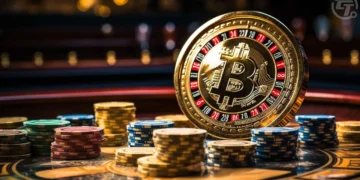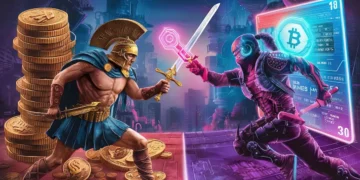Disclaimer: The information presented does not constitute financial, investment, trading, or other types of advice and is solely the writer’s opinion.
- UNI’s price action hit a roadblock at the $4.4 resistance, resulting in another price drop.
- Sellers looked to gain the advantage with an increase in short positions.
Despite the bullish market conditions, Uniswap [UNI] failed to break above the mix of a resistance level and bearish order block at the $4.4 price zone.
Read Uniswap’s [UNI] Price Prediction 2023-24
AMBCrypto’s previous outlook on UNI highlighted the selling pressure that the altcoin was under, with bulls needing to scale multiple price hurdles. While bulls were able to scale the $4.2 price hurdle, the bearish order block at $4.4 was a step too far.
This led to an 8% drop over five days, with UNI trading at $4 as of the time of writing.
Low demand limited bullish rally

Source: UNI/USDT on Trading View
The On Balance Volume (OBV) declined by over $5 million within the period under consideration. This loss of trading volume stalled the bullish rally, which allowed sellers back into the market at the resistance level.
With price trading at a mid-point between the $4.4 resistance and $3.8 support, a retest of the $3.8 support looked more likely in the short term.
This was further supported by the Relative Strength Index (RSI) dropping below the neutral 50 – a sign of weakening buying pressure and an increase in selling pressure.
Thus, both UNI’s price action and on-chart indicators revealed the short-term bearish bias in the market.
Another factor that could be affecting UNI is the recent imposition of an interface fee of 0.15% on Uniswap with traders favoring a sell-off rather than an accumulation, based on AMBCrypto‘s findings.
Traders chose to go short based on UNI’s spot market activity

Source: Coinglass
How much are 1,10,100 UNIs worth today?
Market speculators in the futures market were bearish in the short term. According to Coinglass, the exchange long/short ratio showed that shorts had a 51.38% share of the open contracts on UNI.
This hinted at a further price dip in the short term, with the $3.8 support becoming the best possible price level for another bullish rebound.
Disclaimer: The information presented does not constitute financial, investment, trading, or other types of advice and is solely the writer’s opinion.
- UNI’s price action hit a roadblock at the $4.4 resistance, resulting in another price drop.
- Sellers looked to gain the advantage with an increase in short positions.
Despite the bullish market conditions, Uniswap [UNI] failed to break above the mix of a resistance level and bearish order block at the $4.4 price zone.
Read Uniswap’s [UNI] Price Prediction 2023-24
AMBCrypto’s previous outlook on UNI highlighted the selling pressure that the altcoin was under, with bulls needing to scale multiple price hurdles. While bulls were able to scale the $4.2 price hurdle, the bearish order block at $4.4 was a step too far.
This led to an 8% drop over five days, with UNI trading at $4 as of the time of writing.
Low demand limited bullish rally

Source: UNI/USDT on Trading View
The On Balance Volume (OBV) declined by over $5 million within the period under consideration. This loss of trading volume stalled the bullish rally, which allowed sellers back into the market at the resistance level.
With price trading at a mid-point between the $4.4 resistance and $3.8 support, a retest of the $3.8 support looked more likely in the short term.
This was further supported by the Relative Strength Index (RSI) dropping below the neutral 50 – a sign of weakening buying pressure and an increase in selling pressure.
Thus, both UNI’s price action and on-chart indicators revealed the short-term bearish bias in the market.
Another factor that could be affecting UNI is the recent imposition of an interface fee of 0.15% on Uniswap with traders favoring a sell-off rather than an accumulation, based on AMBCrypto‘s findings.
Traders chose to go short based on UNI’s spot market activity

Source: Coinglass
How much are 1,10,100 UNIs worth today?
Market speculators in the futures market were bearish in the short term. According to Coinglass, the exchange long/short ratio showed that shorts had a 51.38% share of the open contracts on UNI.
This hinted at a further price dip in the short term, with the $3.8 support becoming the best possible price level for another bullish rebound.





















































































how to get cheap clomid price how can i get generic clomid buy cheap clomid without dr prescription cost of cheap clomiphene without insurance can i purchase clomid pills clomid without insurance order clomiphene prices
This is the tolerant of enter I turn up helpful.
Thanks recompense sharing. It’s acme quality.
zithromax 250mg ca – brand ofloxacin 400mg flagyl 400mg cheap
rybelsus us – cyproheptadine tablet cyproheptadine online buy
motilium brand – order generic domperidone buy cyclobenzaprine paypal
inderal 20mg usa – methotrexate 5mg canada buy methotrexate no prescription
purchase amoxil online – order diovan without prescription buy combivent 100 mcg without prescription
azithromycin 500mg pill – azithromycin 250mg us nebivolol 20mg uk
augmentin order online – https://atbioinfo.com/ buy acillin generic
buy esomeprazole 40mg online – anexa mate buy generic nexium
warfarin 5mg oral – anticoagulant losartan 50mg tablet
mobic 7.5mg ca – tenderness order mobic 15mg generic
prednisone 40mg cheap – allergic reactions order deltasone 20mg pills
buy erectile dysfunction drugs – over the counter ed pills where to buy ed pills
how to buy amoxicillin – amoxil price buy cheap generic amoxicillin
diflucan 100mg sale – https://gpdifluca.com/ fluconazole 200mg pill
order cenforce for sale – on this site order cenforce online cheap
cheap cialis by post – https://ciltadgn.com/# does medicare cover cialis
cialis medicine – https://strongtadafl.com/ does cialis raise blood pressure
buy generic zantac for sale – buy zantac 150mg generic order zantac 300mg for sale